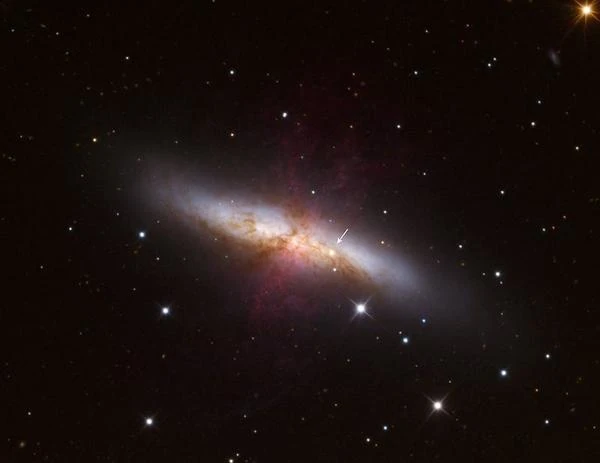
Image description: The explosion of Supernova SN 2014J (small arrow) is in the right part of the Cigar Galaxy (M82). The red hydrogen flames are signs of the star's death. Image source: Adam Block, Mt. Lemmon SkyCenter, U. Arizona.
Supernovae are rare events in our Milky Way, occurring 1 to 3 times per century, but they are observed daily on a universal scale. Supernova SN 2014J is the tenth supernova discovered in January 2014. SN 2014J is located in the Cigar Galaxy (Messier 82) at 11.5 million light-years away.
Astronomer Steve Fossey (1996-) from University College London accidentally discovered this supernova during a demonstration on the use of the CCD camera on one of the 0.35-meter automated telescopes at the Observatory. On January 21, 2014, four undergraduate students had the chance to see a star explosion in a galaxy other than the Milky Way, this is the serendip effect (discovering something by chance). This supernova is the subject of numerous observations around the world, from ground-based telescopes like the Keck Telescope in Hawaii to space telescopes like Hubble.
The Cigar supernova should be bright enough to be visible with binoculars throughout the Northern Hemisphere. SN 2014J is relatively close to us, being at a distance of 11.5 ± 0.8 million light-years (3.5 ± 0.3 megaparsecs). Its name "Cigar Galaxy" comes from the elliptical shape produced by the oblique inclination of its starry disk.
This cosmological candle will allow astronomers to better understand the evolution of supernovae and study the diffuse clouds of galaxy M82 traversed by the electromagnetic spectrum of the supernova. These supernovae are used as "Standard Candles" to determine extragalactic distances. Galaxy M82 appears high in the spring sky of the Northern Hemisphere, north in the direction of the constellation Ursa Major.
The two galaxies M81 and M82 are quite close to each other (about 150,000 light-years apart). Tidal forces accelerate star formation compared to the average observed in galaxies. Galaxies M81 and M82 are located in the constellation Ursa Major.
The death of a star can be gentle or violent, depending on its mass.
Below 1.4 times the mass of the Sun, the star fades very slowly in serenity.
Between 1.4 and 5 times the mass of the Sun, its agony is much more violent. Its radius shrinks to 10 km. The final density is enormous, the nuclei of atoms cannot resist, and the core of the star becomes a gigantic neutron core. The collapse causes a terrible explosion that will project the upper layers of the star into space. A supernova can shine in the sky for months.
Above 5 times the mass of the Sun, the collapse is extremely violent and rapid. It can no longer be stopped. The core of the star becomes a black hole.
N.B.:
The thermonuclear supernova or Type Ia supernova corresponds to the complete explosion of a stellar corpse of the white dwarf type. The Chandrasekhar Limit has been exceeded (exceeding the electron degeneracy pressure) initiated by the capture of matter poured by a nearby companion. Type II, Ib, and Ic supernovae are stars at the end of their life. Type II supernovae have a spectrum containing hydrogen, while Type Ib and Ic supernovae are stars that have already exhausted their hydrogen, so it does not appear in their spectrum. Type Ic supernovae have also exhausted their helium, which no longer appears in the spectrum.
N.B.:
The violence of a star's collapse produces a gigantic explosion that projects the upper layers of the star into space, playing an essential role in the history of life. It is during its supernova explosion that the star releases the chemical elements it has synthesized during its existence and during the explosion itself. These chemical elements will travel through the interstellar medium to spread through space. A supernova will extend over hundreds of billions of km, seeding the interstellar medium with heavy elements, manufactured during the life of the star and during the explosion. These heavy elements are the constituents of terrestrial planets like our Earth.